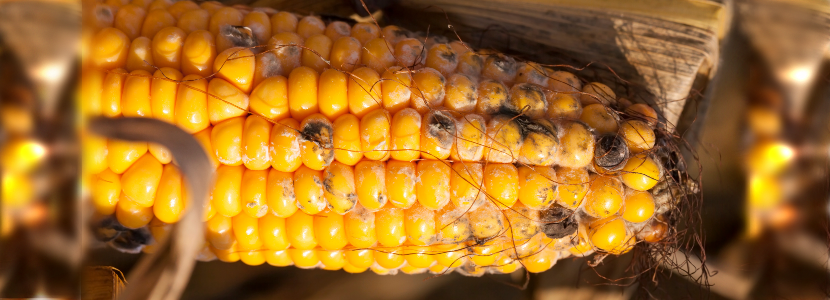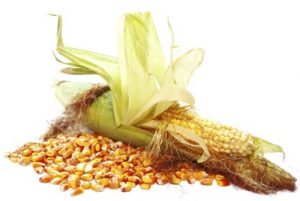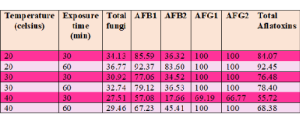 11 Mar 2022
11 Mar 2022
Gaseous ozone presents itself as an interesting alternative to treat mycotoxin contamiantion in corn. The fungi Aspergillus flavus and Aspergillus parasiticus have become a serious concern related to food safety due to their ability to produce aflatoxins, which are toxic to humans and animals.

When animals ingest aflatoxins, these induce immune disorders, weight loss and affect their overall growth and productivity.
Several methods have been used to prevent and control fungal infections in corn during the post-harvest handling and storage period. The application of fungicides is one of the most common methods to control fungi in the crop as it is relatively inexpensive.
Another alternative method to reduce fungal pollution while controlling aflatoxins in corn is the use of gaseous ozone.
Many studies have shown that gaseous ozone is quite effective in reducing fungal and mycotoxin contamination in grains. The penetration and adsorption of ozone depends on:
![]()
Previous studies reported that ozone could inactivate 96% of the fungal spores in barley (Allen et al. , 2003) and decrease 100% of Aspergillus sp. and Penicillium sp. in rice (Santos et al., 2016).
Amongst the advantages of ozone, is the fact that it leaves no residue and does not cause nutritional changes in the product. [register]

Ozone’s mechanism for reducing total fungal infections occurs through the progressive oxidation of cellular components. Ozone reacts with a protective protein layer of the microorganisms’ genetic material rapidly inhibitting growth and reducing the product’s microbial population.
 It’s been reported that in turn, ozone oxidizes polyunsaturated fatty acids or sulfhydryl groups and amino acids from enzymes, peptides and proteins into shorter molecular fragments. In addition, it could also degrade the cell walls of microorganisms (El-Desouky et al., 2012).
It’s been reported that in turn, ozone oxidizes polyunsaturated fatty acids or sulfhydryl groups and amino acids from enzymes, peptides and proteins into shorter molecular fragments. In addition, it could also degrade the cell walls of microorganisms (El-Desouky et al., 2012).
![]() Another study claimed that ozone can reduce the germination of conidia and cause changes in hyphae morphology, resulting in impaired growth and even fungal death (Savi et al., 2015).
Another study claimed that ozone can reduce the germination of conidia and cause changes in hyphae morphology, resulting in impaired growth and even fungal death (Savi et al., 2015).
This study was carried out with the purpose of investigating ozone’s potential to prevent fungal attacks and the formation of aflatoxins in corn. Making it possible to ensure the maintenance of corn quality during its storage period.
Materials and methods
The experimental design used in this study was a completely randomized design with two treatment factors:
Observed corn quality parameters included:
Results and discussion
The results showed that ozone treatment had an effect on reducing total fungal and aflatoxin contamination in corn. However, it had no effect on moisture content, moldy grains, and damaged corn kernels.
The optimal effect was obtained when ozonation was performed at a temperature of 20°C for a 60 minute exposure.
The increase in total fungal infections indicated that aspergillus flavus which was added to corn can grow and develop very well within grains during the 14-day incubation period.
Meanwhile, during the incubation period, Aspergillus flavus was influenced by many factors, such as moisture content, oxygen, light, temperature, humidity and the presence of another fungus. As well as with the presence of macroelements (carbon, nitrogen, phosphorus, potassium and magnesium) and also microelements (iron, zinc, copper, manganese and molybdenum).
This fungus requires a higher temperature, but has the ability to adapt to lower water activity (aw) with a minimum aw of 0.78 and a value of 0.99 aw for its optimal growth .

Efficacy of ozonization on corn quality
The physical and microbiological quality of corn was observed to determine the effects of carbonated ozone exposure on corn quality changes.
The physical qualities observed included moisture content, moldy grains and damaged grains. On the other hand, the observation of microbiological quality included total fungal infections and aflatoxins.
Total fungi: Analysis of variance on total fungal infections showed that temperature, ozone exposure time and interaction had a significant effect on the fungal total with a p<0.05 value.
Tukey’s test results showed that there were significant differences in all treatments. This showed that total fungal infections decreased along with decreasing temperature and increased exposure time.
Ozone treatment at 20°C and for 60 minutes showed the greatest reduction in total fungal infections (Table 4). The level of reduction was closely related to the effect of temperature on the ozone half-life. In which ozone has a longer half-life at low temperatures than at higher temperatures.
Exposure time also affected the reduction of total fungal infections because it was related to the oxidation intensity between ozone and fungi. The longer the ozone exposure time, the greater the oxidation process.

Exposure to ozone at a temperature of 0-20°C recorded a higher inactivation rate of fungal spores, compared to a temperature of 20-40°C (Allen et al., 2003).
The half-life of ozone was significantly reduced by 38% when the temperature increased between 4°C and 24°C and decreased by 48% when the ozone temperature increased between 24°C and 40°C (McClurkin et al., 2013).

The largest reduction in total fungal infections in ozonated corn within this research was about 36.77%. This was slightly different from previous studies, in which most reported that fungal reduction could reach 63% for Aspergillus parasiticus, 70% for Aspergillus sp. and even 100% for Aspergillus flavus (Spanoghe et al., 2016; Santos et al., 2016; Savi et al., 2015).
Aflatoxins: The analysis of variance for aflatoxins showed that temperature, ozone exposure time and their interaction had a significant effect on AFB1, AFB2, AFG1, AFG2 and total aflatoxins with a value of p<0.05.
![]() As with fungal infections, ozone treatment at 20°C and for 60 minutes recorded the greatest reduction in aflatoxins:
As with fungal infections, ozone treatment at 20°C and for 60 minutes recorded the greatest reduction in aflatoxins:
Table 1. Efficacy of ozonization in the count (%) of total fungi and aflatoxins in corn

Ozone’s action mechanism in the degradation of AFB1 and AFG1 involves an electrophilic reaction in the C8-C9 double bond of the furan ring which causes the formation of ozonide compounds. The compound then reorganizes into monozonide derivatives, such as aldehydes, ketones, acids, and carbon dioxide, where the new compounds are non-toxic.
On top of that, ozone is known to directly attack the double bonds of aflatoxins and cause them to break down into organic acids, aldehydes, ketones, and carbon dioxide (Proctor et al. , 2004).
Conclusion
In conclusion, the use of ozone in grains with longer exposure times has no effect on their nutritional quality, chemical composition and functional properties. Therefore, it is safe to be used in grains such as corn, peanuts, soybeans, rice and wheat.
Its effect on reducing fungal and aflatoxin contamination in corn was demonstrated in this study.
The gaseous ozone treatment that showed the greatest reduction of total fungal colonies and total aflatoxins was at a temperature of 20°C and an exposure time of 60 minutes.
[/register]
Subscribe now to the technical magazine of animal nutrition
AUTHORS

Nutritional Interventions to Improve Fertility in Male Broiler Breeders
Edgar Oviedo
The Use of Organic Acids in Poultry: A Natural Path to Health and Productivity
M. Naeem
Synergistic Benefits of Prebiotics and Probiotics in Poultry, Swine, and Cattle
Gustavo Adolfo Quintana-Ospina
Hybrid Rye Potential in Laying Hen Feed Rations
Gwendolyn Jones
A day in the life of phosphorus in pigs: Part I
Rafael Duran Giménez-Rico
Use of enzymes in diets for ruminants
Braulio de la Calle Campos
Minerals and Hoof Health in the Pregnant Sow
Juan Gabriel Espino
Impact of Oxidized Fats on Swine Reproduction and Offspring
Maria Alejandra Perez Alvarado